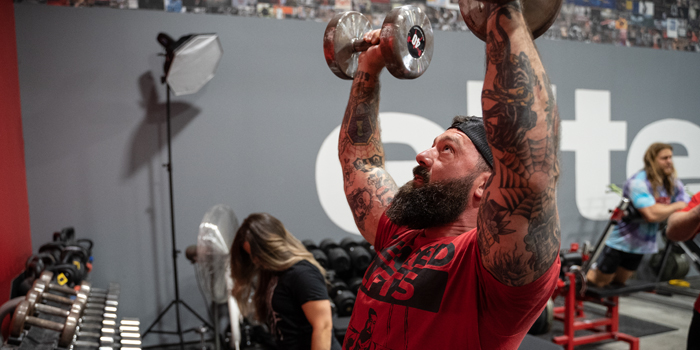
I have a STRONG bias towards the concurrent Westside Conjugate Method, (see what I did there). The reason I mention this is that I like to use terms like max effort (moving something that's heavy) and dynamic effort (moving something as fast as possible). The method I’m going to describe here will fit in any type of periodization, but only if you use common sense (harder for some than others). I put strength as a top priority for my combat athletes (YES, WE STILL CONDITION THEM!).
Wipe any preconceived notions that boxers, grapplers, jiu-jitsu athletes, and mixed martial artists shouldn’t be weight training from your mind. Although I do not consider myself a leading authority on this subject, some of the bigger names that I’ve studied (and their approach to strength training combat athletes) are Phil Daru, Joel Jamison, Loren Landow, and of course Westside Barbell.
RECENT: Foam Training Alternatives for Bench Pressing
After you read this article, Google their names and make sure to thank me later. I have read and soaked in all their knowledge and implemented parts into my own training. This is all my first-hand experience that I’ve passed down with my athletes and in the right circumstances to myself (giggity). Before we move this discussion to programming considerations it’s important to note that the skills for specific sports will rise with the raising of the athlete’s absolute strength. Don’t be afraid to make them strong.
Programming Considerations
This program is for athletes with weight training experience that ranges from novice to intermediate.
When you become part of a serious combat athlete’s regiment, you must take into account the skills needed for their sport. Use the “coach’s eye" so to speak. Watch the athlete’s movement as they walk in through the door, as they're warming up, and check their overall demeanor. Be prepared to make the adjustments based on your observations. I don’t care if you had the best session planned out. Sometimes doing some breath work and light pump work is needed for the day. I like to utilize a two-day conjugate training layout that’s been coined as "condensed conjugate,” because an active combat athlete will be training five to six days per week. This normally looks like this:
Day 1: ME Upper/ DE Lower
Day2: ME Lower/ DE Upper
Both days would ideally be spread 48 hours apart. My mantra here is “Less is more.” Pick easily accessible but effective exercises.
Funny how everything I keep hammering away about sounds like it should be applied to all training and sports.
Favorite Lower Body Compound Exercises
- Zercher Squat Variations
- Zercher Good Morning Variations
- Sumo Variations
- SSB Reverse Lunge (Yes, we can make this a modified max effort movement)
- Belt Squat Squats
- Belt Squat Good Mornings
Favorite Upper Body Compound Exercises
- Overhead Press Variations
- Close-Grip Bench Press Variations
- Floor Press Variations
- Weighted Pull-ups
- Weighted Dips
- Weighted Push-ups
Favorite Lower Body Accessory Movements
- Bulgarian Split Squats
- Leg Curls
- Reverse Hyper®
- Belt Squat March Variations (Marching while gable gripping a large Med Ball, Spud Front Squat Harness Marching, marching while pummeling, marching while carrying dumbbells, etc.)
- Sled Drags (All variations)
- Wheelbarrow Walks
- Kettlebell swings
Favorite Upper Body Accessory Movements
- Single-Arm Press Variations
- DB Rolling Extensions
- JM Press
- Tate Presses
- Chest Supported DB and BB Rowing
- Upper Body Sled Drags
- Zercher Carries
- Stone Carries
- Sandbag Carries
Favorite Neck and Grip Training
- Neck Harness Extensions
- Plate on Forehead Extensions
- Wrestler's Neck Bridge
- Chin to Shoulder Rotations (Unweighted or against bands)
- Weight Loaded Grip Machine, (For time and reps)
- Grenade Ball Pull-ups and Dead Hangs
- Bucket of Rice Gripping
- Finger Grip Weight Loaded Machine
Favorite Conditioning Training
- Short Rest Periods Between Training/Circuit Training
- Dynamic Effort Work (Focus on being explosive)
- Carries
- Airdyne Sprints
- Battle Rope Interval Training
- Barbell Complexes
- Sport-Specific Type Drills (NO, NOT AGILITY LADDERS FOR F*#K SAKES—Heavy Bag Ground and Pound, Pummeling with a Partner, etc.)
Plyometric Exercises
- Long Jumps
- Continuous Long Jumps (Bounding)
- Vertical Jumps
- Kneeling Jumps
- Med Ball Chest Pass
- Med Ball Overhead Throws
- Med Ball Slams
Each one of these exercises or drills serves a specific purpose to the athlete. Knowing when and how to use them is what makes them effective. I also like to keep it simple. For example, I use vertical jumps to measure explosive lower body power. You can get as fancy as you want here, but basic movement variations will work for a very long time in gauging an athlete's progress. Listen, I conjugate hard AF, but using one to two variations is HUGE in terms of movement selection (i.e. a Pin Zercher Squat, set at a specific height will provide different stimulus and feedback than a Zercher Squat). Don’t get lost in the sauce here because it's easy to get caught up in all the different variations. Remember to Keep it Simple, Stupid (KISS).
Another thing I'd like you to consider is making this fun for your athletes! Weight training is their GPP, so keeping them engaged will help you reap more benefits. One way I like to do this is to include aspects of their sport. During our sled drags, I have them pummel each other while they drag the sled (if you have more than one athlete). A little competition can be fun! While on the belt squat, I like them to throw punching combinations and switch their stance. Be creative! I cannot stress this enough, USE COMMON SENSE!
Last consideration, DELOAD them regularly. I like every four weeks but this is up to you. Like I said above, combat athletes do so much training that taking one extra precaution will only help them in the long run. Every time I ignore this, I notice more aches, pains, and a reduction in strength and athleticism, especially within my overweight self.
Sample Programming
Day 1: Max Effort Upper/ Dynamic effort Lower
Warm-up:
- RPR Wake-up drills and Diaphragmatic breathing
- Max neural drive pull ups 4-5 x 1
- Sled drags 1-2 trips
Working Sets:
- Push Press 1RM
- Wide stance parallel or slightly above Box squat 5x5x40%+ bands, chains, or weight releasers
Accessory Work Circuit 1:
*Repeat 3-4 times
- Pull-ups x 8-12
- Vertical jumps x 3
- Hanging leg raise x 20
Accessory/Conditioning Circuit:
*Repeat 5+ times
- Airdyne Sprints x 8-10 secs
- Weight loaded Grip machine X30 secs
- Weighted neck harness ext x 15-20
Day 2: Max effort Lower/ Dynamic Effort Upper
Warm-up:
- RPR Wake-up drills and Diaphragmatic breathing
- Explosive KB swings 1-2x 20 (Explosive but in control)
- Sled drags 1-2 trips
Working Sets:
- Zercher Pin Squat set at halfway through the Movement 1RM
- Close Grip Bench Press 5x5x40%+ bands, chains, or weight releasers
Accessory Work Circuit 1:
*Repeat 3-4 times
- DB RDL x 8-12
- Med Ball Chest Pass x 3
- Standing Ab crunch x 20
Accessory/Conditioning Circuit:
*Repeat 5+ times
- Battle Ropes x 10-15 secs
- Grenade Ball Dead Hangs X30 secs
- Chin to Shoulder Rotations x 15-20 ea direction
This program is a basic two-day, one-week micro-cycle, training cycle, or whatever your favorite social media influencer is calling it these days. Every movement has a purpose. Now what's cool is they also have their own regressions and progressions.
If you have a fighter that’s brand new to weight training, start them doing some simple Goblet Squats. As they get better motor control, they can graduate to a Box Squat. If you have a more advanced athlete with good movement patterns and body control, do a Zercher Squat with heavy band tension.
Figure out the weakness and plan your exercises accordingly. If the fighter has pillow-soft punches, program some Rolling Dumbbell Extensions to support that extra pop at the end of their punch.
Is your athlete lacking lateral speed? That’s built off of—you guessed it—lateral strength. Good old-fashioned Sumo Deadlifts, Wide Stance Box Squats, and Belted Squat Marches.
Really bad grip issues? You can work it into your athlete’s main movements: 3RM Weighted Pull-ups.
Don’t overcomplicate anything. Start small and add more complexity over time.
I've been training fighters for about five years now and with each one I have learned something different. At the end of the day, these athletes are here with purpose and intent. Watching them reap the rewards of their programming and hard work is amazing. Miguel Sevasin is an up-and-coming amateur MMA fighter out of Massachusetts. He's a good friend (and athlete of mine) and he won Amateur KO of the year in the cage titans. Getting to watch his strength and confidence in the octagon was one of my favorite moments of being a coach.
Like always, any questions or comments let me know! I'll help build your programming to fit your needs or we can bounce ideas off of each other. I’m going to leave you with this like the good Dr. Ken Leistner used to say, “Speed kills, but strength punishes."
Chad Faria is a competitive powerlifter (raw with wraps) from New Bedford, Massachusetts. He owns Bristol County Barbell club—a one-car garage and a 450-square-foot carport. Chad is a Westside Special Strengths Coach, RPR Level 1 Practitioner, PN1 Coach, and ISSA Master Certified Personal Trainer. Aside from his son, fiancé, and livelihood, his barbell club is one of the biggest priorities in his life. Chad's goal is to help whoever is serious about becoming the most dangerous and strongest version of themselves.











4 Comments